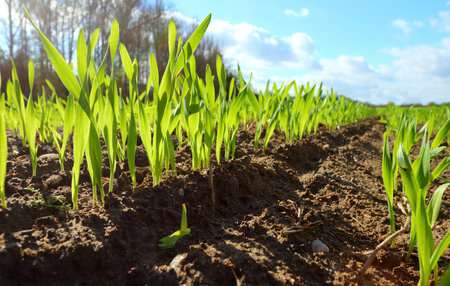OMAFRA cereals specialist discusses this year’s winter wheat, and what to keep in mind when deciding on nitrogen rates
By Jennifer Jackson
Spring is finally here – time to start thinking about winter wheat and nitrogen (N) applications, says Joanna Follings, cereals specialist for the Ontario Ministry of Agriculture, Food and Rural Affairs.
Winter wheat across the province survived the winter quite well, according to Follings. This status is somewhat thanks to the crop’s early planting in 2016 that allowed plants to become well-established and tillered prior to winter.
And the wheat has been handling the recent rains well.
“We’ve seen a lot of rain in the past few days but it has not been freezing,” says Follings. Because of this, “we are not seeing a lot of icing over happen,” which is good news for the crop thus far.
On average, most winter wheat is in its tillering phase and is showing thick, healthy plant stands. This staging means it is time to start thinking about N applications.

abadonian/iStock/GettymagesPlus
Farmers should aim to apply their first N application in mid- to late April but should keep in mind a few factors when determining rates, says Follings.
“Something to keep in mind is that some of the wheat out there is quite big,” she says. “We want to reduce our lodging risks, (through the use of) a split nitrogen application – a first application in April and the rest later on in the growing season in May.”
Farmers should also remember their fungicide plan when applying nitrogen.
“From past research, we have seen that when applying high rates of nitrogen, you (may) not see that gain in (wheat) yield without a fungicide application,” she says. “If we are going to be pushing 120 or even 150 pounds of nitrogen, we want to make sure we are also applying a fungicide.”
For those who are not planning to apply fungicide, Follings recommends no higher than 90 pounds of N per acre to minimize disease and lodging risk.
“For those that are pushing those high rates of nitrogen, we recommend that the grower has experience with high rates on their fields – maybe they have done strip tests or have tried high rates in the past,” she says.
With high rates of N, growers should also think about sulfur (S) applications, and recognize the 10:1 relationship between the two, according to Follings. For every ten pounds of N, farmers should apply one pound of S.
“For those producers that … have not worked with or applied sulfur before, (they may want to) try it in strips to see (their crop’s) response and difference in yield,” especially on their soil type and field.
Just as important as determining nutrient application rates, farmers should also be scouting and assessing their crops, says Follings.
“Get out, get in the field, get (some) stand counts (and) assess for any disease,” she suggests. “Get to know what is going on in your crop early on in the season.”